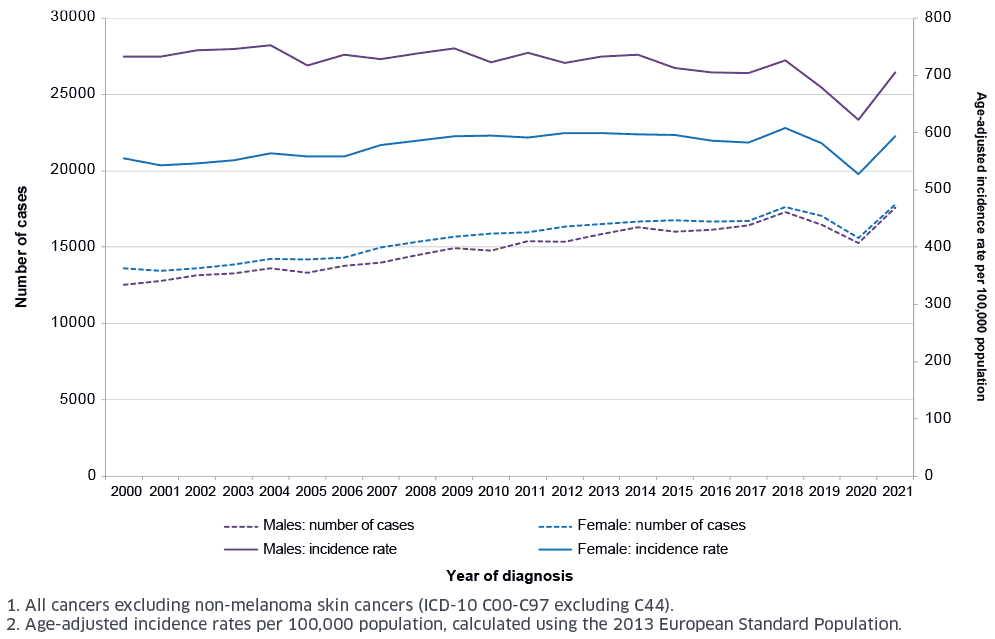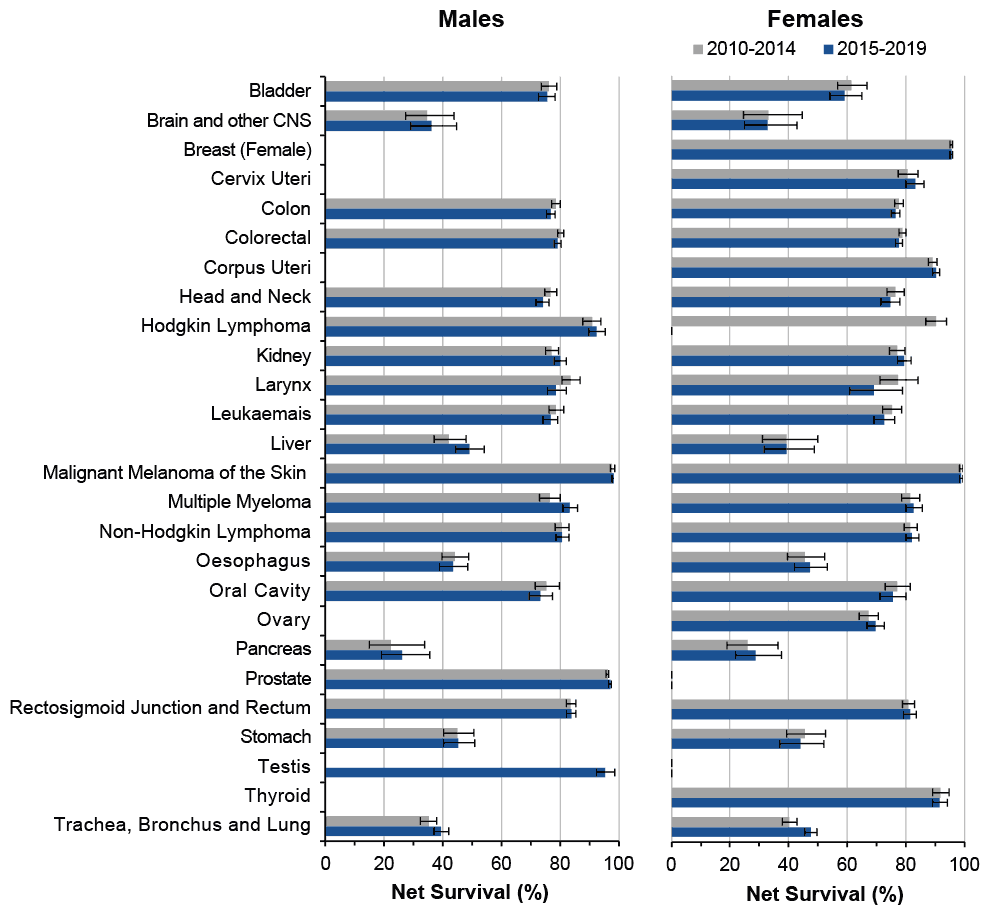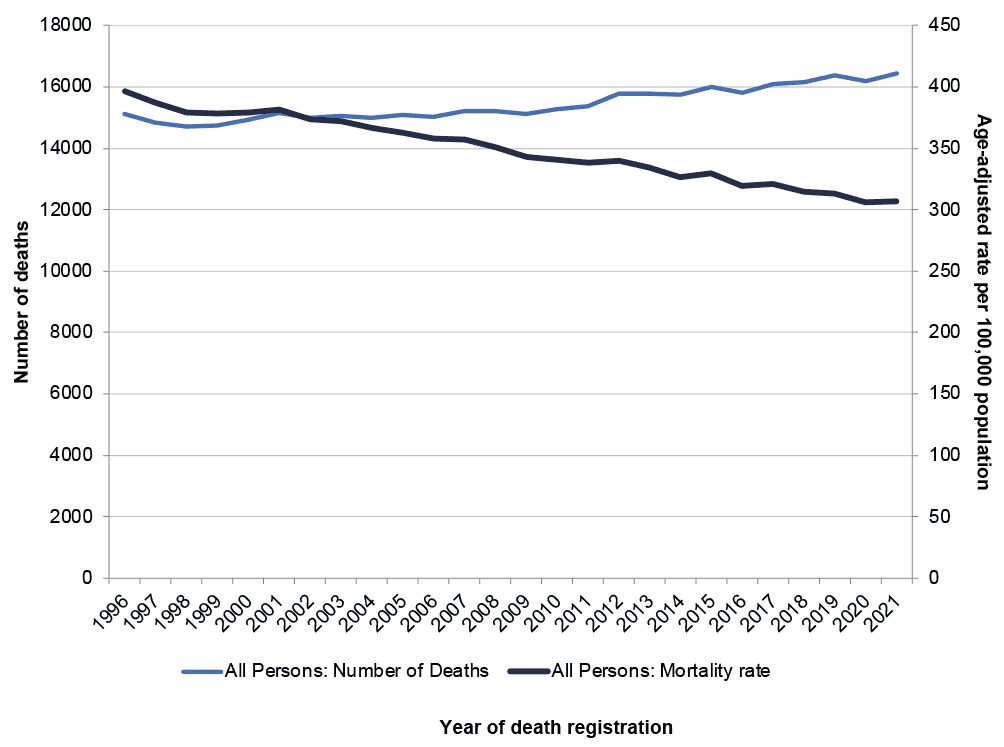Cancer strategy 2023 to 2033
This Cancer strategy for Scotland sets out our vision for the next ten years to improve cancer survival and provide excellent, equitably accessible care. It was developed in collaboration with people with lived experience and our wider partners.
2. Cancer in Scotland
PHS publishes a wide range of statistics including cancer incidence, survival and mortality. These cancer statistics include analysis by tumour type, gender, age and deprivation.
Cancer Research UK (CRUK) publishes a wide range of important research.
2.1 Incidence

There were 35,379 new cancers registered in Scotland (17,600 male; 17,779 female) in 2021 (an increase of 5.5% compared with 2019). This is in-line with a long-term trend of increasing number of cancer diagnoses over time. The rate, or risk, of new cancers also increased to 644 per 100,000 (an increase of 3.1% compared with 2019) and was higher than expected from the long-term trend. These statistics for 2020 and 2021 need to be seen in the context of the pandemic and will continue to be monitored closely.
The risk of all cancers (excluding non-melanoma skin cancers) has historically been higher in males than females. The gap has steadily decreased over time; it reached its lowest in 2019 with a difference of 14.9% and slightly increased to 16.9% in 2021. To understand the implications of these trends over time, each cancer needs to be considered separately, alongside the contrasting patterns between the number and rate of cancer between the sexes.
Lung cancer is the most common cancer, although breast and prostate cancers are the most common in females and males, respectively.
Data from 2021 show increased cancer risks for those living in the most deprived areas: a person living in the most deprived areas of Scotland is 30% more likely to develop cancer than one living in the least deprived areas, although this does vary by cancer type.
This overall pattern is strongly influenced by higher rates of smoking-related cancers in more deprived areas. For example, lung cancer is three times more common in the most deprived areas compared with the least deprived areas in Scotland.
When looking at cancer staging, the earlier a person is diagnosed with cancer, the more likely they are to have a good outcome. Four out of five breast cancers (78%) were diagnosed at an early stage (I or II). In contrast, two-thirds of lung cancers (66%) and more than two in five colorectal cancers (44%) were diagnosed at a late stage (Stage III or IV). There was convincing evidence that socio-economic deprivation increased the likelihood of being diagnosed with more advanced cancers of the cervix, breast in females, head and neck, and prostate.

Age-standardised incidence rates by SIMD 2020 deprivation quintile, persons.
2.2 Survival

Data published in 2022 allows us to look at both the 1-year and 5-year survival outcomes at the same time. Survival for all cancer patients combined (excluding non-melanoma skin cancers) improved, at both one and five years, between 2010-14 and 2015-19, by around two percentage points for males and one percentage point for females.
During the five-year period 2015-19, for adults who were diagnosed with cancer, two thirds of males (69%) and females (72%) survived for at least one year, while 2 in 5 males (44%) and 1 in 2 females (51%) survived for at least five years. This varies by cancer types, however, with 1-year survival ranging from around 20% to almost 100%.
Reasons for improved cancer survival include diagnosis at an earlier stage and use of more effective treatments.
2.3 Mortality

Between 2012 and 2021, the overall risk of dying from cancer has decreased but the number of deaths due to cancer has increased over the same period. This largely reflects Scotland’s aging population as the risk of developing cancer is more common among older people.
Between this 10 year period, the age-adjusted cancer mortality rate for all cancers combined decreased by 11%, with a greater decrease in males (14%) than in females (7%). The continuing decrease in cancer mortality rates is consistent with long-term trends. Therefore, it appears that the pandemic did not adversely impact cancer mortality rates in 2021.
Lung cancer was the most common cause of death from cancer in Scotland (3959 deaths in 2021). Almost a quarter of all deaths from cancer in Scotland were attributed to lung cancer, 45% more deaths than colorectal cancer, the next most common cause of death from cancer.
People living in the most deprived areas were 74% more likely to die from cancer, compared with the least deprived. The possible reasons for these patterns are
complex and reflect modifiable and non-modifiable risk factors for developing cancer, uptake of screening, access to treatments and other health conditions.
2.4 Projections
Around 35,400 people are diagnosed with cancer in Scotland each year – more than 4 people every hour. Based on CRUK research, the number of cases is projected to rise by nearly one fifth, to around 42,100 new cases per year in 2040.[12] This would continue the long-term trend of an increasing number of cancer diagnoses over time.
Contact
Email: cancerpolicyteam@gov.scot
There is a problem
Thanks for your feedback